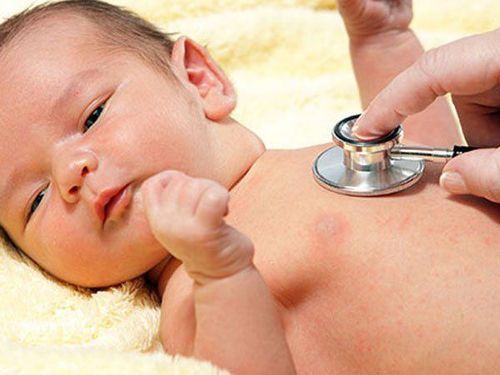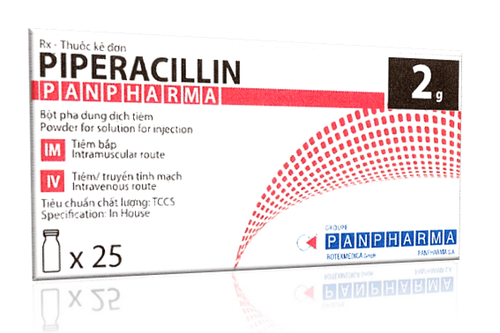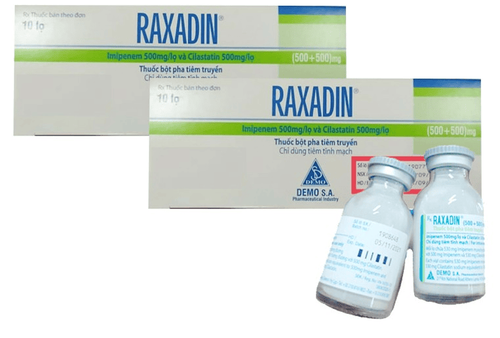This is an automatically translated article.
The article was professionally consulted with Specialist Doctor II Cao Thi Thanh - Pediatrician - Pediatrics - Neonatology - Vinmec Hai Phong International General Hospital.Neonatal sepsis is a severe infection caused by bacterial colonization that occurs during the neonatal period. The signs of infection in children are sometimes very aggressive but sometimes vague, if not detected and treated early, there will be a bad prognosis, long-term sequelae. Therefore, preparing these knowledge is extremely necessary to be a parent in the first days.
1. What is neonatal sepsis?
Neonatal sepsis occurs in 1 to 9 per 1,000 live births. The incidence was highest in very low birth weight infants and premature infants.Because of the severity of the disease and the potential for sequelae, as soon as sepsis is suspected, antibiotic therapy should be initiated as soon as possible after sufficient specimens have been collected. go to culture. However, even if it is not possible to obtain a culture, antibiotics should not be delayed.
Babies with a diagnosis of sepsis require care in the neonatal intensive care unit until full days of antibiotics have been given or until sepsis can be ruled out.
2. Causes of neonatal sepsis
Neonatal sepsis is divided into two large groups with different pathogenicity.2.1. Early-onset sepsis (within the first 48 hours of life)
Early-onset neonatal sepsis often presents with pneumonia and/or evidence of sepsis. The rate of sepsis in boys and girls is equal and there is a very high risk of death, ranging from 10 to 30%.Sepsis at this time is mainly caused by microorganisms during labor. Occasionally, children also develop disseminated intracellular sepsis, which occurs with the agent Listeria. However, up to 80% of cases are caused by group B strep and gram-negative bacteria.
2.2. Late-onset sepsis (after the first 48 hours)
Pathogens are acquired during the postpartum period in the hospital, for example Staphylococcus when the baby is cared for in the Neonatal Intensive Care Unit (NICU).Boys have the disease higher than girls. Infants with birth weight below 1000g are particularly at risk. The mortality rate is about 5%.
More than 70% of cases are caused by Staphylococcus and Staphylococcus aureus; The remaining 10 to 15% of cases are caused by gram-negative bacteria. Candida is also an important pathogen, especially in extremely low birth weight infants.

3. Risk factors for neonatal sepsis
3.1. Early onset sepsis
Prolonged rupture of membranes (> 18 hours); Pregnancy failure ; Hyperthermia in the mother (> 38oC) or the mother has an infection such as urinary tract infection, gastrointestinal infection; Obstetric procedures, including cervical stitches; Premature birth ; A history of previous neonatal group B Streptococcus infection; There is evidence of group B Streptococcus infection during this pregnancy.3.2. Late-onset sepsis
Length of hospital stay such as premature birth, low birth weight; Having interventional procedures on the body such as placing intravenous needles, endotracheal tubes; Cross-contamination by healthcare workers and parents; There are birth defects, such as anomalies of the urinary tract, neural tube.4. Manifestations of neonatal sepsis
Signs of neonatal sepsis are often non-specific because they are easily confused with other congenital or acquired diseases such as heart failure or respiratory failure, metabolic disorders,...Sometimes manifestations are symptomatic. High alert is the subjective feeling of a mother when her child "looks" abnormal. Meanwhile, up to a third of confirmed cases are sepsis despite appearing normal.
4.1. General features of neonatal sepsis
Pale, lethargic, jaundiced; Fever, hypothermia, temperature instability; Poor tolerance; Hypoglycemia or hyperglycemia; Blood gas testing disorders (including acidosis and elevated lactate).4.2. Symptoms in the respiratory system
Increased respiratory rate; Stop breathing; Traction breathing; Cyanosis.
4.3. Symptoms in the cardiovascular system
Fast heart beat ; slow heart rate; Poor perfusion to target organs; Low blood pressure.
4.4. Symptoms on the skin
Occurrence of death; Bruise marks; Bleeding from injection sites.4.5. Symptoms in the digestive system
Poor suckling; Vomiting; Distention; Food intolerance; Liquid stools.4.6. Symptoms in the central nervous system
Lethargy; Listless; Constant crying; Convulsions.5. Diagnosis of neonatal sepsis
To diagnose neonatal sepsis, especially in cases of vague manifestations, testing is extremely necessary. Moreover, these are important parameters to help assess the overall health of the newborn. These tests include:Complete blood count Blood gases; Electrolyte concentration; Blood sugar; Tests to confirm the infection such as quantitative C-reactive Protein (CRP), procalcitonin; Tests to identify the causative agent are blood cultures, cerebrospinal fluid cultures, urine cultures, sputum cultures, and stool cultures. The results of the culture help guide the sensitive antibiotic to be used to kill compatible bacteria.
6. Treatment of neonatal sepsis
Antibiotic therapy is the mainstay of treatment in cases when only the possibility of infection is suspected. In early-onset sepsis, initial treatment should include ampicillin and aminoglycosides. Cefotaxime may be added to or substituted for aminoglycosides if meningitis caused by gram-negative bacteria is suspected. Antibiotics should be changed immediately to the most sensitive group when culture results are positive and antibiogram is available.Late-onset neonatal sepsis should also be treated with ampicillin plus gentamicin or ampicillin plus cefotaxime. If gram-negative meningitis is suspected, ampicillin, cefotaxime, and aminoglycosides can be used. In late-onset hospital-acquired sepsis, initial treatment should include vancomycin (active against methicillin-resistant S. aureus) plus an aminoglycoside. If P. aeruginosa is an important epidemiological factor in the current setting, ceftazidime, cefepime, or piperacillin-tazobactam may be used in addition to, or instead of, an aminoglycoside depending on local susceptibility.
In general, the route of antibiotics is always intravenous infusion with a dose depending on the child's weight per day and the duration, usually 7 to 14 days, possibly longer if co-infection with fungi. In addition, children also need other supportive treatment such as respiratory support, hemodynamic stability, body temperature maintenance, nutritional support, immunity assurance... along with care and hygiene activities. born. The effectiveness of these concomitant treatments also contributes to their success in fighting infection.
7. Prevention of neonatal sepsis

During labor, it is necessary to choose a quality medical facility, hygiene, and highly qualified staff to ensure the safest first days of life for mother and baby. In the following days of child care, it is necessary to know how to observe in order to detect abnormal signs early, quickly take the child to the hospital for timely intervention, avoid complications of blood infection and delayed treatment.
In short, neonatal sepsis is a common disease with high mortality and severe sequelae. Early detection and preventive measures from the fetal stage are extremely necessary to help the baby have the most solid first days of life.
Vinmec International General Hospital is the leading prestigious medical address in the examination, diagnosis and treatment of neonatal diseases, including neonatal sepsis.
Vinmec always focuses on ensuring the professional qualifications of the team of pediatricians and constantly training and learning more from advanced medical backgrounds in the world. The system of medical machinery and clinics at Vinmec meets international standards, and the quality of service is aimed at bringing absolute satisfaction to customers. For sensitive and vulnerable patients such as infants, choosing a hospital that ensures comprehensive expertise, medical ethics and facilities is extremely important to protect immature health. for children.
Please dial HOTLINE for more information or register for an appointment HERE. Download MyVinmec app to make appointments faster and to manage your bookings easily.














